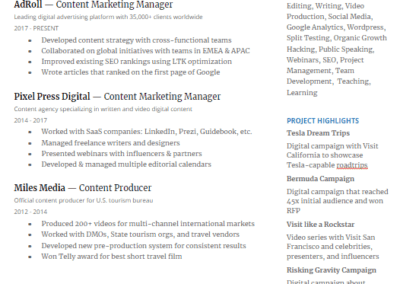
What’s the best color for your resume? Here’s how to decide.
There’s a lot of misleading advice when it comes to whether you should use color on your resume. The advice on what’s the best resume color ranges from, “never use color, only black and white,” (according to Career Thinker) to the more common, “adding color is a great way to make your resume stand out” (according to Resume Coach).
Unfortunately, a lot of the guidance on what’s the best resume color comes from the opinions of writers, not actual recruiters, designers or data. In this post I’ll dispel the rumors of whether you should use color on a resume and we’ll go over a few of the best ways to use color on a resume to boost your chances of landing a interview.
Resume color depends on context
Making any blanket statement about what’s the best resume color will inherently be wrong. This is because your resume should always reflect the type of job you’re applying for.
Applying to be the VP of Engineering at a Fortune 1000 company? Don’t use any color on your resume (except maybe your name).
Applying to be an intern at an ad agency? A pop of a well-chosen color will help you stand out.
The tricky thing about using color on your resume are the in-between cases when you’re not applying to a completely creative role or a completely formal role.
Based on talking to dozens of recruiters, working with dozens of resume students, and my own experience of applying to over 230 jobs, my recommendation is to add just one color on your resume in most cases.
Let’s break down the rationale behind this and look at some research as well.

Why Color on Resumes Works
When thinking about whether to use color on a resume it’s important to keep in mind who is reading your resume.
If you’re applying to a company of over 100 people, most resumes are read by recruiters or someone on the HR team. As we discuss in the Interviewing for Introverts course, a recruiter is reading dozens if not hundreds of resumes every day.
Do you think they want to scan through a bunch of black and white PDFs that all look the same?
After all, a recruiter is a human being, just like you and me.
Adding a little bit of color to your resume not only helps you stand out, but it also helps the person reading your resume scan through the information easier.
In design theory, color is part of a system that designers use to create “visual weight.” You can think of visual weight as anything that draws your eye in.
Bold type, for instance, has more visual weight than regular type.
ALL CAPS type also has more weight.
And BOLD ALL CAPS type has even more weight than that.
Color is also an element that creates visual weight.
The important thing to keep in mind when using any of these design techniques is to use them very, very, VERY sparingly.
The reason that people recommend not using color in a resume is because most people overdo it and end up pulling the recruiter’s eyes away from the important information.
But, if we use color correctly, we can actually help the recruiter find the most important information quickly.
And speed is crucial when it comes to landing a job, since recruiters will only spend between 10–30 seconds on your resume.
Let’s take a look at the same resume, but with and without color.
Click on each image below and scroll to compare them with and without color.
Which resume is easier to scan through quickly? Which one feels more organized? Which resume do you think will make a better impression?
Using a highlight color on your resume is helpful and (along with other hacks) can help you land a job faster.
The trick is to use color on a resume sparingly and purposefully to attract the recruiter’s eyes to the most important sections you want them to look at.
Choosing the best color for your resume
If you read other articles about using color on a resume you’ll generally hear that adding color to your resume will be, “a distraction and unprofessional.” The type of resume that this usually refers to is something like this:

This resume is a classic example of bad design principles. This is a bad use of color in a resume because it overpowers the information on the resume and makes it hard to read.
So yes, the people who are referring to these kinds of resumes are correct.
The use of color is bad.
But, there are much better ways of using color in a resume that will actually boost your chances of getting hired.
A great example of this is the Clean & Blue resume template that a lot of my resume course students have used to get interviews at top companies such as Facebook, Expedia, Kaiser, LinkedIn, and many more.
 This template comes from Google’s recommended resume templates and (with a few modifications) it made a huge difference when I was looking for a job.
This template comes from Google’s recommended resume templates and (with a few modifications) it made a huge difference when I was looking for a job.
As soon as I started using this template (which features a highlight color) I started getting 27% more calls for interviews.
Sometimes when I would recommend the template to my resume course students, however, they would tell me that it didn’t really fit the information that they were trying to put into their resume.
That’s when I started experimenting with other templates and eventually found the Professional Green template that looked like it would suit their needs.
 I modified this template and then helped a few job candidates adapt their resumes into it. Then we sent out the resumes to their desired roles and a few weeks later I started getting emails from candidates with a lot of exclamation points in them.
I modified this template and then helped a few job candidates adapt their resumes into it. Then we sent out the resumes to their desired roles and a few weeks later I started getting emails from candidates with a lot of exclamation points in them.
The results were incredibly successful!
Their interview rates instantly went up and a few of them landed jobs soon after.
In order to make sure that these weren’t just anomalies, I contacted a few of the recruiters I work with and shared some of the resume templates with them.
I asked, “Is this resume template good? Is it okay that the resume has color in it?”
They unanimously approved.
Two ways of choosing the best color for your resume
You can choose a resume color based on the emotion you’d like to convey or on the branding of the company you’re applying to.
According to Toptal, a top UX designer marketplace, colors can be broken down in the following ways:
- Red — Red is the color of danger and passion, as well as excitement. It’s a very strong color and can elicit strong reactions in people. Lightening it to pink makes it more feminine and romantic while darkening the hue to maroon makes it more subdued and traditional.
- Orange — Orange is a very creative color that’s also associated with adventure and youth. It’s very energetic, too.
- Yellow — Yellow is happy, optimistic, and cheerful. Brighter yellows are popular in creative designs. Darker shades of yellow become gold, which is associated with wealth and success.
- Green — Green has varied associations. On one hand, it provokes feelings of wealth and tradition (particularly darker hues), while on the other it’s strongly associated with environmentalism and nature. Lime greens are often associated with renewal and growth.
- Blue — Blue is most often associated with loyalty and trust. Brighter blues can be affiliated with communication, while duller and darker blues can be associated with sadness and depression. Blue is the most universally liked color in the world, which may explain why so many companies opt for blue shades for their branding.
- Purple — Purple is another hue with varied meanings. It’s long been associated with royalty and wealth. But it’s also associated with mystery and spirituality. Purple can also evoke creativity.
In general, you should be conservative when choosing a color for your resume. You don’t want to use extremely bright colors or ones that evoke a very strong emotion.
Remember to keep the recruiter in mind. You don’t know who this person is or how they’ll interpret the color you’ve chosen.
So I generally recommend staying away from strong colors and going with a neutral color like blue or green, which tend to be used by a lot of companies.
Another hack for choosing the best resume color is by using the same color as the company you’re applying for.
You can google “(company x) brand colors” and you’ll usually find their color scheme in their brand guidelines. This is a great subtle way of showing them you’re in tune with their company and have been thoughtful about your application.
So, what’s the best color for a resume? It all depends on the company you’re applying for and what you’re trying to convey. In general, however, it’s best to use a highlight color in your resume to help the recruiter read through your resume easier.
If you'd like to learn more ways to improve your resume, you can watch our entire resume course for free here.
The course will take your resume from the bottom 10% to the top 10% in 60 minutes or less and all the techniques are backed by data and real-world experience.
Get 1-on-1 Help
Need to land your job ASAP? Fast forward your job search with some 1-on-1 help! 👇
More from the blog:

Best Resume Builders of 2023 (Pros & Cons + Prices)
Modern resume builders use AI, ATS-friendly templates, and active recommendations to help you build your perfect resume faster than ever before. In this post we’ve rounded up the 5 best resume builders of 2023.
How to Beat the ATS in 25 Minutes | The Ultimate Guide
In this guide I’ll show you how to beat the ats (applicant tracking system), plus I’ll give you 2 ATS-friendly resume templates and a free tool to test if your resume is ATS-friendly.
Accelerate your career with a course!
Tired of waiting to hear back from hiring managers? Speed up your job search with one of our accelerated courses. Learn how to optimize your resume, improve your LinkedIn, and nail your interviews to get hired within weeks!
Bogdan Zlatkov is the Founder of GHYC and author of "The Ultimate Guide to Job Hunting", ranked #1 on Google. He has been featured in the Wall Street Journal, Fast Company, HR Dive, and more. At GHYC, Bogdan creates job search courses & tools by working with award-winning career coaches, best-selling authors, and Forbes-Council members. Prior to GHYC, Bogdan led the content programs at LinkedIn Learning.


